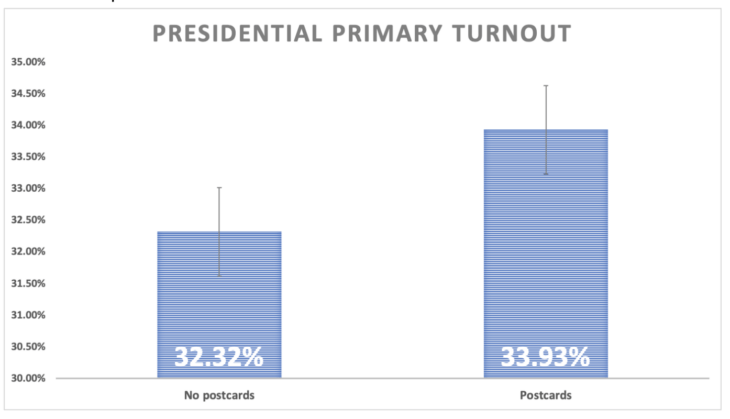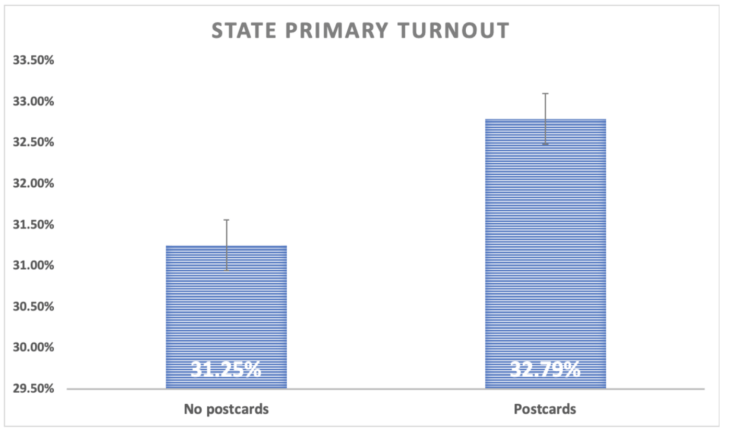Abstract: SDAN ran this experiment in the 2020 primary elections to test whether sending GOTV (Get Out the Vote) postcards meant to educate voters about the two primary system in their states would help to turn out voters for both primaries. Voters in three states that hold separate presidential and state primaries were randomly assigned to receive either no postcard, or two postcards reminding them about the primaries and providing information about how to vote. It was found that voters who received postcards were significantly more likely to vote in both primary elections (ps = 0.010) than people who did not receive postcards. This, combined with previous postcarding results, indicates that postcarding during primary elections may be especially useful.
Objective: This study sought to determine if voter turnout among low-to-mid turnout propensity, high support voters could be improved by sending a GOTV/voter education postcard to voters ahead of each of the 2020 state and presidential primaries in Florida, Georgia, and Minnesota.
Background: Recent industry research suggests that sporadic voters are being somewhat ignored by political operatives. This lack of engagement may, in turn, keep fueling these voters’ low chances of voter turnout. Further, a dearth of communication may leave these voters uneducated about important aspects of the electoral system in their state, including the fact that, in many states, separate primaries are held on different dates to nominate presidential candidates and candidates running for all other state and federal offices. Candidates running in the state primary, usually held at least a couple of months after the Presidential primary, tend to see lower voter turnout than candidates running for President, and both primary elections see lower voter turnout than the general election. For this reason, it is important to turn out as many voters as possible for both primary elections. Sending voter education/GOTV postcards may help to educate voters about the existence of the two primary system in their state (as well as the information they need to vote), and mobilize voters to the polls.
Specifics: SDAN pulled a list of all registered voters who fit inclusion criteria (have a partisanship score of 80-100, indicating high support for Democrats, and a mid to low non-Presidential primary election voter turnout propensity scores of 25-60) in several state legislative districts in Florida, Georgia, and Minnesota. We randomly selected 10,000 voters from each state’s list, and randomized each state’s list into the 2 conditions: control or postcard. This resulted in a sample size of 30,000.
We recruited Sister District volunteers to write the GOTV postcards and mail them to an in-state partner approximately two weeks before each primary election. In-state partners put postcards in the mail for local mailing 3-5 days after the volunteer mailing deadline. It is assumed that voters in this study received postcards approximately a week before the election encouraging them to vote. SDAN then reviewed the voter file to determine if voters in the sample voted in either or both of the primary elections held in their state. Due to the Coronavirus pandemic, the presidential primary in Georgia was cancelled and Georgia held only 1 primary, and thus they were removed from this analysis.
Basic Takeaways
Handwritten postcards were effective in increasing voter turnout in Florida and Minnesota.
- The increase in turnout for both the presidential and state primaries was statistically significant and the magnitude of the effect is larger than we generally see in postcarding studies.
The cost of this tactic was relatively cheap, coming in at $31-$32 a vote.
- Since these communications targeted Democratic leaning voters, almost all of these were likely net Democratic votes.
Key Findings
Postcards boosted presidential and state primary voting significantly in Minnesota and Florida.
-
- People who received postcards were significantly more likely to vote in the primary elections than people who did not receive postcards (ps = 0.010). For the presidential primary, the odds ratio indicated that postcard receivers were approximately 8.3% more likely to vote than people who did not receive postcards.
- For the state primary, the odds ratio indicated that postcards receivers were also approximately 8.2% more likely to vote than people who did not receive postcards.


Additional Findings
The cost per vote for this tactic is quite good compared to many other tactics.
-
- The postcard condition generated 1.54% more voters than the control condition in Florida and Minnesota in the state primary (10,000 * 0.0154=154), indicating that the votes generated by the postcards in the state primary cost about $32 each (10,000*$0.50=$5,000 / 154 = $32.47).
- The postcard condition generated 1.61% more voters than the control condition in Florida and Minnesota in the presidential primary (10,000 * 0.0161=161), indicating that the votes generated by the postcards in the presidential primary cost about $31 each (10,000*$0.50=$5,000 / 161 = $31.06).
- Cost per vote for GOTV tactics varies by tactic and election type, among other things. Green and Gerber report an average range of $31-$91 dollars per vote for GOTV tactics like canvassing and phonebanking in mostly academic research (2015). Industry estimates SDAN is aware of range from about $15 per vote to over $250 per vote.
Caveats and considerations
Primaries are quieter.
- This study was run during primary elections, which is known to be a quieter kind of environment than a general election. It is expected that tactics run in less noisy elections will be more effective than tactics run during a general election. In this case, the quieter environment of the primary election may have allowed the postcards to be a tactic that caught voters’ attention.
Focused on a unique set of voters.
- This study specifically targeted voters with low- to mid- voter turnout propensity scores for the primary (25-60). This means that the study results may not generalize to voters in the 0-25 or 60+ propensity range. This sample also targeted specific, competitive state house and senate districts in Minnesota and Florida, and did not draw a random sample from the entire state.
This study was statistically underpowered.
- We are underpowered to detect the true effect of postcards, which means the same study should be replicated in a larger sample to determine if these effects are reliable.
Contributions and Future Directions
This study builds on SDAN’s 2020 postcard postmark study to compile more information about primary postcarding. Both studies indicate that postcarding during the primaries is promising, with fairly large effects in both studies. This indicates that more studies focusing on postcarding in primary and special (i.e., quieter) elections should be conducted.
Future research should focus on replication and expanding to different election types, perhaps including municipal elections. Further, these postcards focused on GOTV and voter education, but this method could also be tested for persuasion or for appeals on the issues. More research is needed to determine the best practices for primary postcarding, but the current research indicates it is a promising avenue,
If you’re interested in reading more about this study, a longer report is here: Two Primaries Short Report
References:
Green, D. P., & Gerber, A. S. (2015). Get out the vote: How to increase voter turnout.
Tab. Brookings Institution Press.
SDAN’s commitment: It is SDAN’s intention to provide as much context as possible to allow for the nuanced interpretation of our data. SDAN’s convention is to contextualize effects by reporting p values, confidence intervals, and effect sizes for all models tested (these items may be in the longer report linked in the blog). Additionally, SDAN always differentiates between planned and exploratory analyses and a priori and post hoc tests, and reports the results of all planned analyses regardless of statistical significance. If you have questions about these findings please email Mallory.



